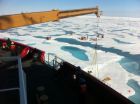(Press-News.org) A team of researchers, including scientists from Woods Hole Oceanographic Institution (WHOI), discovered a massive bloom of phytoplankton beneath ice-covered Arctic waters. Until now, sea ice was thought to block sunlight and limit the growth of microscopic marine plants living under the ice.
The amount of phytoplankton growing in this under-ice bloom was four times greater than the amount found in neighboring ice-free waters. The bloom extended laterally more than 100 kilometers (62 miles) underneath the ice pack, where ocean and ice physics combined to create a phenomenon that scientists had never seen before.
The study, published June 8 in the journal Science, concluded that ice melting in summer forms pools of water that act like transient skylights and magnifying lenses. These pools focused sunlight through the ice and into waters above the continental shelf north of Alaska, where currents steer nutrient-rich deep waters up toward the surface. Phytoplankton under the ice were primed to take advantage of this narrow window of light and nutrients.
"Way more production is happening under the ice than we previously thought, in a manner that's very different than we expected," said WHOI biologist Sam Laney, who was part of the multi-institutional team led by Kevin Arrigo of Stanford University.
Just as a rainstorm in the desert can cause the landscape to explode with wildflowers, this research shows that events like pooling melt water can happen on very short timescales in the Arctic yet have major effects on the ecosystem.
"If you don't catch these ephemeral events, you're missing a big part of the picture," Laney said.
The unexpected discovery occurred during a 2011 expedition aboard the U.S. Coast Guard icebreaker Healy. It was part of the NASA-funded ICESCAPE program to investigate the impact of climate change in the polar Chukchi and Beaufort seas.
The scientists found themselves in the right place at the right time in early July of 2011, as the Healy made its way above the Arctic Circle and into year-old ice. Atop the meter-thick ice, pools of sky-blue melt water were accumulating as the Arctic summer progressed.
Researchers expected that, as in years past, the waters beneath the ice would have minimal amounts of chlorophyll—the fluorescing hallmark of photosynthetic marine plants. Instead, they observed the opposite. As the ship broke further into the ice, chlorophyll in the dark waters below shot up to levels rarely observed even in the most productive ocean regions. It became evident that there was a phytoplankton bloom of astonishing magnitude happening under the ice. Optical measurements showed that four times as much light penetrated ice covered by meltwater ponds than ice covered by snow.
"Although the under-ice light field was less intense than in ice-free waters, it was sufficient to support the blooms of under-ice phytoplankton, which grew twice as fast at low light as their open ocean counterparts," the study notes.
The ship conducted transects into the ice pack to determine how far and deep the bloom extended. Measurements of biomass showed the largest part of the bloom occurred far away from the open ocean, under thick ice and close to water upwelling at the continental shelf break, where the shallow coastal shelf plunges steeply into deeper water.
Another member of the ICESCAPE team, WHOI physical oceanographer Bob Pickart showed that easterly winds churned out by monster storm systems along the Aleutian Islands can reverse the current along the shelf break. The change in circulation drives cold, nutrient-rich water up from the abyss and refreshes the supply of nutrients available to phytoplankton growing near the surface.
"Without a doubt the bloom was enhanced at the shelf break," Pickart said.
As the melt pools introduced light through the ice, phytoplankton in shelf break waters likely experienced something akin to an all-you-can-eat buffet.
What types of organisms participated in the bloom? Laney caught them on camera with an instrument he had brought to sea—the Imaging FlowCytobot, an automated microscopic imaging system invented at WHOI and built by Laney and co-developer Dr. Rob Olson.
Since their return, Laney and MIT/WHOI Joint Program graduate student Emily Brownlee have been working with the Imaging FlowCytobot's other co-developer and ICESCAPE team member, WHOI biologist Heidi Sosik, to sort through and classify organisms in the millions of images collected by the instrument and unravel intricacies of the under-ice bloom. The images showed that the bloom was not caused by fallout from algae growing on the ice, but rather it contained different organisms that seized the confluence of currents, light, and nutrients.
The Imaging FlowCytobot offers tantalizing insights into the microbial dynamics and food web of this dramatic Arctic algal boom. For example, the images consistently showed some phytoplankton in the bloom in a half-munched state, offering clues to the planktonic grazers that might be eating them.
Discovering the under-ice bloom "was very serendipitous," Pickart said, but the difficulty of exploring the harsh, remote region also leaves it wide open for surprises.
INFORMATION:
The Woods Hole Oceanographic Institution is a private, non-profit organization on Cape Cod, Mass., dedicated to marine research, engineering, and higher education. Established in 1930 on a recommendation from the National Academy of Sciences, its primary mission is to understand the oceans and their interaction with the Earth as a whole, and to communicate a basic understanding of the oceans' role in the changing global environment.
Scientists discover huge phytoplankton bloom in ice-covered waters
2012-06-08
ELSE PRESS RELEASES FROM THIS DATE:
How Negligence Can Turn A Surgical Sponge Into A Deadly Object
2012-06-08
In hospitals throughout Illinois and the rest of the United States, about one in every 6,000 surgical patients faces a common complication: Surgeons mistakenly sew up a patient while leaving a foreign object inside the surgical site, often a surgical sponge.
The consequences of this surgical error can be painful and even deadly, because the body reacts unfavorably to a foreign object. For example, one victim suffered increasing pain after abdominal surgery, complaining repeatedly to his doctors until they finally reopened his incision five months later and discovered ...
Rice, UCLA slash energy needs for next-generation memory
2012-06-08
HOUSTON -- (June 7, 2012) -- Researchers from Rice University and UCLA unveiled a new data-encoding scheme this week that slashes more than 30 percent of the energy needed to write data onto new memory cards that use "phase-change memory" (PCM) -- a competitor to flash memory that has big backing from industry heavyweights.
The breakthrough was presented at the IEEE/ACM Design Automation Conference (DAC) in San Francisco by researchers from Rice University's Adaptive Computing and Embedded Systems (ACES) Laboratory.
PCM uses the same type of materials as those used ...
'Nanocable' could be big boon for energy storage
2012-06-08
HOUSTON -- (June 7, 2012) -- Thanks to a little serendipity, researchers at Rice University have created a tiny coaxial cable that is about a thousand times smaller than a human hair and has higher capacitance than previously reported microcapacitors.
The nanocable, which is described this week in Nature Communications, was produced with techniques pioneered in the nascent graphene research field and could be used to build next-generation energy-storage systems. It could also find use in wiring up components of lab-on-a-chip processors, but its discovery is owed partly ...
Cardinal Web Solutions Featured in Entrepreneur
2012-06-08
Alex Membrillo, the co-founder of Cardinal Web Solutions, an Atlanta Internet Marketing firm, was recently featured in an article for Entrepreneur.com. Written by Lambeth Hochwald, the piece, "5 Ways to Make Sweet Music for Your Business," was published on May 29, 2012. It discusses how music can be used to positively influence sales and motivate staff.
In the article Mr. Membrillo explains how Cardinal Web Solutions (CWS) uses music to energize employees, encourage innovative ideas, and recognize achievements. "In the ever changing world of Internet ...
Safe, simple eye test may help save lives by preventing stroke
2012-06-08
SAN FRANCISCO – June 7, 2012 – A simple eye test may someday offer an effective way to identify patients who are at high risk for stroke, say researchers at the University of Zurich. They showed that a test called ocular pulse amplitude (OPA) can reliably detect carotid artery stenosis (CAS), a condition that clogs or blocks the arteries that feed the front part of the brain. It's a known risk factor for stroke. The OPA test could be performed by ophthalmologists – physicians who treat eye diseases – during routine exams. The study, which is published in the June issue ...
Floating dock from Japan carries potential invasive species
2012-06-08
NEWPORT, Ore. – When debris from the 2011 earthquake and tsunami in Japan began making its way toward the West Coast of the United States, there were fears of possible radiation and chemical contamination as well as costly cleanup.
But a floating dock that unexpectedly washed ashore in Newport this week and has been traced back to the Japanese disaster has brought with it a completely different threat – invasive species.
Scientists at Oregon State University's Hatfield Marine Science Center said the cement float contains about 13 pounds of organisms per square foot, ...
What does it mean to be cool? It may not be what you think
2012-06-08
Do rebelliousness, emotional control, toughness and thrill-seeking still make up the essence of coolness?
Can performers James Dean and Miles Davis still be considered the models of cool?
Research led by a University of Rochester Medical Center psychologist and published by the Journal of Individual Differences has found the characteristics associated with coolness today are markedly different than those that generated the concept of cool.
"When I set out to find what people mean by coolness, I wanted to find corroboration of what I thought coolness was," said Ilan ...
Element Six and Harvard University collaboration sets a new quantum information record
2012-06-08
7 June 2012: Element Six, the world leader in synthetic diamond supermaterials, working in partnership with academics in Harvard University, California Institute of Technology and Max-Planck-Institut für Quantenoptik, has used its Element Six single crystal synthetic diamond grown by chemical vapour deposition (CVD) to demonstrate the capability of quantum bit memory to exceed one second at room temperature.
This study demonstrated the ability of synthetic diamond to provide the read-out of a quantum bit which had preserved its spin polarisation for several minutes and ...
Mrs. Alaska, Brandy Wendler, Partners with Find Me Gluten Free to Raise Awareness for the Gluten Free Community
2012-06-08
Find Me Gluten Free, the most downloaded gluten-free restaurant and business finder app for iPhone and Android announces partnership with Brandy Wendler, Mrs. Alaska International 2012 to create awareness for the Celiac Disease and Gluten Free Community.
Find Me Gluten Free rates businesses on how gluten-free friendly they are, making it easier to find a restaurant which users can be confident will take preparing a gluten-free meal seriously, along with serving as a brand-finder at stores nationwide.
Brandy Wendler was diagnosed with Celiac Disease in 2008. It was ...
NationaLease Spring Maintenance Managers Meeting Generates New Ideas, Provides Training, Inspires Attendees
2012-06-08
The NationaLease Spring Maintenance Managers Meeting in Greenville, SC, in May provided attendees with a stimulating mix of technology, product, and professional education, as well as a strong measure of motivation and inspiration provided by its keynote speaker, Jay Blake, racing's only blind race crew chief.
The four-day event also included a ceremony announcing NationaLease's Exceptional Service Award winners, which are NationaLease member companies that provided particularly outstanding reciprocal road service to fellow members throughout the year. "This year's ...




